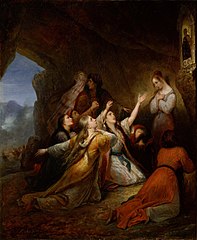Dance Of Zalongo
Dance of Zalongo Greek: Χορός του Ζαλόγγου, Horos tou Zalongou) refers to the mass suicide of women and their children from Souli that occurred in the aftermath of the invasion of Ottoman troops on December 16, 1803.
The event is commemorated in Greece in the context of the Greek War of Independence. About 60 women were trapped near the village of Zalongo in Epirus, now modern Greece, then the Ottoman Empire, who decided to turn towards the cliff's edge and die with their infants and children rather than to submit to the Ottoman troops chasing them. According to tradition they did this one after the other while dancing and singing. The name also refers a number of Greek theatrical dramas and a song in folk style, commemorating the event, named the Dance of Zalongo.
 Les Femmes souliotes by Ary Scheffer | |
| Date | 1803 |
|---|---|
| Location | Epirus, Greece |
| Cause | Souliote War (1803) |
| Casualties | |
| 60 dead mass suicide | |
The story of the Zalongo women became so popular within the Greek community that more Greek women chose to commit suicide rather than suffer rape and lifelong torture. During the Greek War of Independence, in Naoussa, in the early 1820s, after a long siege of the city by Ottoman forces thirteen women with their children took refuge in a hill above the waterfall of the river Arapitsa, in Stoubanos. The city was burning due to a mass conquest by Ottoman forces the woman followed their sisters the Souli women of Zalongo and jumped to their deaths with their children into the Arapitsa of Naoussa. In the 1950s the city of Naoussa was awarded the official title Heroic City and a monument was erected at the site in the 1970s by Greek sculptor Katerina Halepa Katsatou in their honor.
History


During the Souliote War in December 1803, the Souliotes began evacuating Souli after their defeat by the forces of the local Ottoman-Albanian ruler, Ali Pasha. During the evacuation, a group of Souliot women and their children were trapped by Ali's troops in the mountains of Zalongo in Epirus. In order to avoid enslavement and rape, the women threw their children first and then themselves off a steep cliff, committing suicide. The incident is also mentioned by Christoforos Perraivos in his 1815 edition of the History of Souli and Parga.

According to the legend, they jumped down the precipice one after the other while singing and dancing. The incident soon became known across Europe. The story reached the English-speaking world in the 1820s. During the Greek War of Independence, the story was used throughout England and the United States to gain sympathy for the war. Articles repeated a story about 100 women from Souli who took their lives along with their children while singing and dancing to avoid capture. European painters used the theme in their works. At the Paris Salon of 1827, the French artist Ary Scheffer exhibited two Romantic paintings, one of which was entitled Les Femmes souliotes ("The Souliot Women"). French female painter Constance Blanchard painted Greek Women of Souli Running to Their Death in 1838, it was also exhibited at the Paris Salon that same year. Today, the Zalongo Monument on Mount Zalongo in Kassope commemorates their sacrifice.
Theatricals and Songs
There is a popular Greek dance-song about the event, which is known and danced throughout Greece today. It was part of popular drama, written by Sp. Peresiades, published in 1903 and staged first in 1904. The Greek folk song "Dance of Zalongo" has the following lyrics:
| English | Greek |
|---|---|
Farewell poor world, | Έχε γεια καημένε κόσμε, |
Peresiadis describes this part of his drama as a "chorus of women", which can be translated as "dance", but in that context it possibly means a "group of women", as that in ancient Greek drama.
An Albanian dance-song called Vallja e Zallongut ("Dance of Zalongo") was developed with lyrics that refer to the same aforementioned mass suicide, published in 1961 by Sako Zihnni:
| Albanian | English |
|---|---|
Lamtumirë, o Sul, i shkretë, | Goodbye, oh desolate Souli, |
Paintings
- Dance of Zalongo by Claude Pinet
- Dance of Zalongo by Filippo Agricola
- Souli Women with the Virgin Ary Scheffer
- Dance of Zalongo by Theophilos Hatzimihail
See Also
References

Sources
This article uses material from the Wikipedia English article Dance of Zalongo, which is released under the Creative Commons Attribution-ShareAlike 3.0 license ("CC BY-SA 3.0"); additional terms may apply (view authors). Content is available under CC BY-SA 4.0 unless otherwise noted. Images, videos and audio are available under their respective licenses.
®Wikipedia is a registered trademark of the Wiki Foundation, Inc. Wiki English (DUHOCTRUNGQUOC.VN) is an independent company and has no affiliation with Wiki Foundation.



